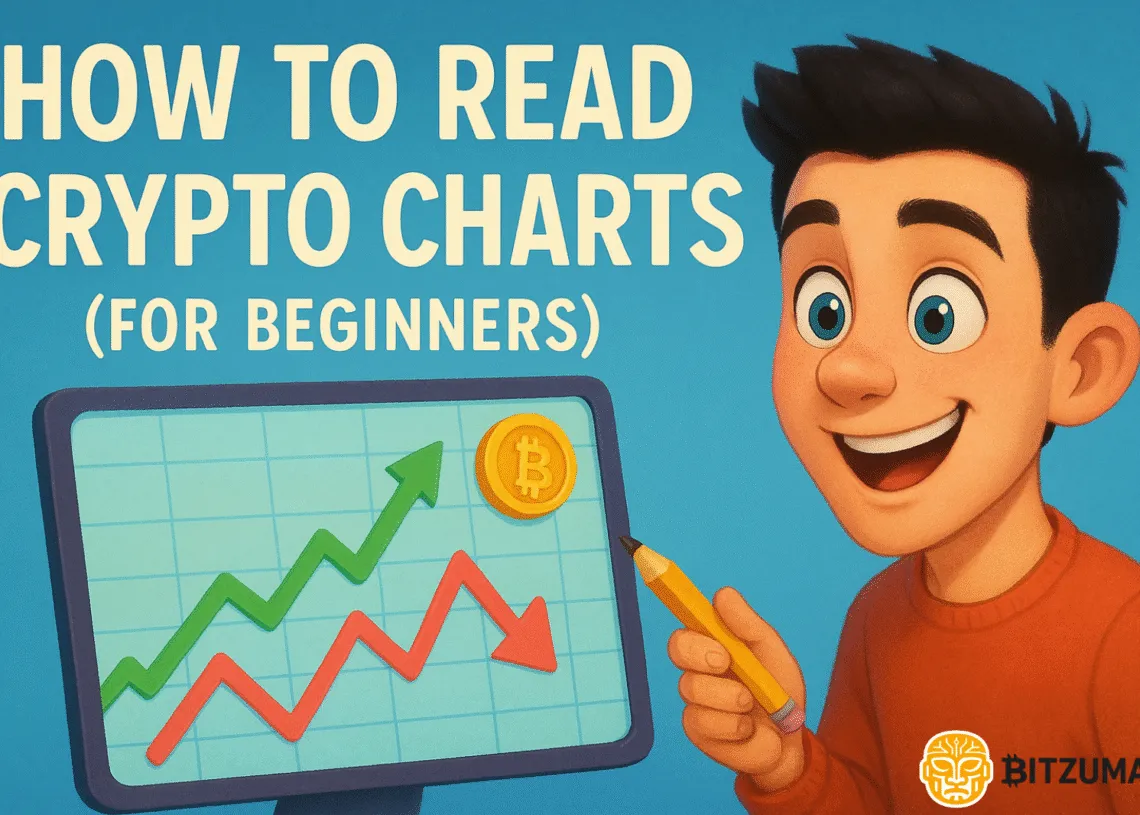If you’ve ever stared at a Bitcoin price chart and felt completely lost, you’re not alone.
At first glance, crypto charts can seem like a mess of lines, candles, and indicators — but once you understand the basics, they become powerful tools that help you:
- Make better entry and exit decisions
- Understand market behavior
- And most importantly: Avoid emotional trading
Reading charts doesn’t mean predicting the future. It means seeing where the market has been — and using that information to make smarter moves moving forward.
Whether you’re a casual investor, an active trader, or just curious, learning how to read crypto charts will give you a massive edge in 2025 and beyond.
Pro Tip: You don’t need to master 100 indicators. Start with price, volume, and trend. That’s already 80% of the game.
Want to build a strategy around it? Read: How to Trade Crypto (2025 Beginner’s Strategy)
What Is a Crypto Chart and Why Does It Matter?
At its core, a crypto chart is just a visual representation of a coin’s price over time.
Instead of staring at numbers, you get a picture that shows how the market moved — where people bought, where they sold, and where emotions took over.
But it’s not just about the price.
Most crypto charts also show:
- Volume – how much was traded
- Timeframes – from minutes to months
- Indicators – like moving averages, trendlines, or momentum
These elements help you spot patterns, trends, and key levels — things that don’t always show up when you just look at the price itself.
Think of a chart like a map:
- The past is the road behind you
- The current price is where you are now
- And your job is to figure out where you might be heading next
You don’t need to become a technical analysis wizard. But even a basic reading skill will help you avoid emotional decisions and FOMO-driven moves.
Fun Fact: Most professional traders say that price action (i.e., just reading the candles and support levels) is more useful than any fancy indicator.
Candlestick Charts Explained (Simple & Visual)
The most common type of chart in crypto is the candlestick chart — and no, it has nothing to do with candles you light on your desk.
Each candlestick tells you what happened during a specific time period, whether that’s a minute, an hour, or a day.
Here’s what a single candle shows:
- Open – the price at the beginning of the timeframe
- Close – the price at the end of the timeframe
- High – the highest price reached
- Low – the lowest price reache
Green Candle = Price went up
The close is higher than the open.
Red Candle = Price went down
The close is lower than the open.
Together, candles form patterns. Some traders try to interpret them like clues — looking for signals of trend reversals or continuations.
You don’t need to memorize dozens of patterns to get started.
Just understanding how candles form already helps you read market momentum.
Pro Tip: Zoom out to a daily or 4H chart to spot clearer, more meaningful candles. Zooming in too much = more noise, less clarity.
Support, Resistance & Trendlines (Your Navigation System)
Reading charts isn’t just about seeing what the price is — it’s about spotting where price reacts.
That’s where support and resistance come in.
What is Support?
Support is a price zone where buyers tend to step in.
It’s where the market says:
“Hey, this is cheap — I’ll buy.”
If the price falls to that level, it often bounces back up.
What is Resistance?
Resistance is the opposite: a zone where sellers dominate.
It’s where people say:
“This is getting expensive — I’ll sell.”
When the price reaches that point, it often pulls back down.
These zones aren’t exact numbers — they’re areas. And the more times price touches a level and reacts, the stronger that level becomes.
Pro Tip: When a resistance breaks and the price stays above, it often becomes new support — a classic concept called “role reversal.”
Trendlines: Drawing the Bigger Picture
A trendline is a simple diagonal line that shows the market’s direction:
- Connect the lows in an uptrend
- Connect the highs in a downtrend
Trendlines help you:
- Identify momentum
- Avoid trading against the market
- Spot breakouts and reversals
Think of them as “dynamic support and resistance” that move with the trend.
Key Indicators to Watch (Optional but Useful)
Once you’re comfortable with candles, support/resistance, and trendlines, you can start exploring indicators.
These are tools that help confirm what you’re seeing — they don’t predict the future, but they can give you confidence when making decisions.
Ecco i principali che vale la pena conoscere come principiante:
Moving Averages (MA)
A moving average smooths out price data over time.
The two most common types are:
- SMA (Simple Moving Average)
- EMA (Exponential Moving Average) – gives more weight to recent price
They help you:
- Spot trends (up/down)
- Identify dynamic support/resistance
- Avoid trading against the flow
When the price is above the moving average, the trend is usually up — and vice versa.
RSI (Relative Strength Index)
The RSI tells you if a coin is overbought (too hot) or oversold (too cheap), on a scale from 0 to 100.
- RSI > 70 → Might be overbought
- RSI < 30 → Might be oversold
It doesn’t mean it will reverse, but it helps you spot exhaustion in trends.
Volume
Volume shows how many coins were traded at each price/time.
A price movement with high volume = strong signal.
Low volume? Could be a fakeout.
Rising prices + rising volume = stronger trend confirmation.
How to Read a BTC Chart (Step-by-Step Walkthrough)
Let’s put everything together with a real-world example: a simple Bitcoin chart on TradingView.
Whether you’re using BTC, ETH, or any other coin — the logic is the same.
Step 1: Identify the Trend
Zoom out to the 4-hour or daily timeframe.
Ask yourself:
- Are the lows getting higher over time? (Uptrend)
- Are the highs getting lower? (Downtrend)
- Or is it just going sideways?
Don’t trade against the trend unless you really know what you’re doing.
Step 2: Draw Support & Resistance Zones
Look for:
- Levels where price bounced up (support)
- Levels where price got rejected down (resistance)
Mark them with horizontal lines or shaded zones.
Step 3: Analyze the Candles Around Those Zones
Is price consolidating near support?
Is there a big rejection wick near resistance?
Look at the shape of candles — they reveal buying and selling pressure.
Step 4: Add a Simple Indicator (e.g., RSI or EMA)
Check if:
- RSI is near 30 (possibly oversold) or over 70 (possibly overheated)
- EMA is below price (bullish) or above (bearish)
This adds confidence to what you’re already seeing with your own eyes.
Step 5: Ask Yourself: Is This a Good Area to Buy or Wait?
- If price is bouncing off support + trend is up + RSI is neutral → might be a buy zone
- If price is at resistance + trend weakening → might be time to wait or take profit
You don’t need a perfect system.
Just use these tools to make better-informed decisions.
FAQs on How to Read Crypto Charts
Do I need to know technical analysis to invest in crypto?
Not necessarily. But learning how to read a chart helps you avoid buying the top or panic-selling the dip. Even basic chart literacy makes a big difference.
Are chart patterns always accurate?
No. Patterns can increase your probability, but they’re not guarantees. Always combine chart analysis with logic, risk management, and current news.
What’s the best timeframe for beginners?
Start with 4H (4-hour) or 1D (daily) charts.
Lower timeframes (15m, 5m) are full of noise and better suited for experienced day traders.
Can I trade just using support and resistance?
Yes — many traders rely mostly on price action and key levels.
Indicators are helpful, but you don’t need a dozen lines on your chart to be successful.
Conclusion – Charts Don’t Lie (But They Don’t Predict, Either)
Learning how to read crypto charts won’t turn you into a market wizard overnight — but it will help you make smarter, calmer, and more informed decisions.
Focus on:
- Candlestick basics
- Support and resistance zones
- Trendlines and one or two simple indicators
And most of all: practice.
The more charts you look at, the more natural it becomes.
The goal isn’t to predict the market. It’s to stop being surprised by it.
What to Read Next:
- How to Buy Crypto Without KYC in 2025 (Full Guide)
- Best Crypto Portfolio Trackers for 2025 (Free & Paid Tools)

















